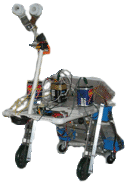
 |
Rover DK-001 (Tarantula)
|
-OVERVIEW- | ||||||
 About:
About: Drive Train:
Drive Train:
  
|
 Assembled:
Assembled:
 
|
 DK-001B (First Mutation):
DK-001B (First Mutation):
  
|
 DK-001C (Second Mutation):
DK-001C (Second Mutation):
  
|
 DK-001D (Third & Final Mutation):
DK-001D (Third & Final Mutation):
  
|
 Additional Pics:
Additional Pics:

|
The completed chasis prior to the attachment of any hardware.
|
 Viewer Comments
Viewer Comments Leave A Comment
Leave A Comment|
|
|
|